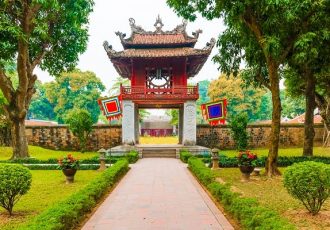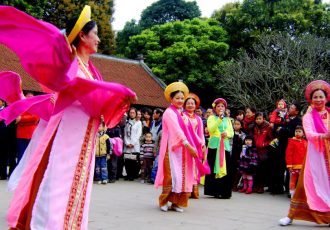Hanoi Museum of Ethnography
The Hanoi Museum of Ethnography is a product of Vietnamese-French cooperation. It is considered one of the most beautiful museums in Vietnam. Built in 1987 and inaugurated in 1997, this monument is a well-known tourist site in Hanoi. This museum was designed by Vietnamese architect Ha Duc Linh and French architect Véronique Dollfus.

This museum is also an ethnographic research center where cultural heritage is preserved and the socio-cultural diversity of Vietnamese ethnic groups is promoted. It presents the 54 Vietnamese ethnic groups with their habits and their costumes, their cultural characteristics…
This museum is divided into three distinct parts. First, an interior area which is named the building of Trong Dong (Bronze Drum) focuses on the different ethnic groups of Vietnam. Then, you can’t miss an open-air architectural garden where many traditional houses of ethnic minorities are located. Finally, in a new building – the Kite building, a collection of crafts from Southeast Asian countries is exhibited. This area brings you enriching experiences!
When entering the Trong Dong building, you can see the Neu tree – the ritual pole of the Cor people in Quang Nam. This mast of the sacrifice of the buffalo is at the center of the ceremonies in honor of the deities, representing the link between them and humans. The buffalo is attached to it. This collective work of the villagers expresses the strength of the Cor inhabitants.
Among the Viet, the Neu tree is a long bamboo pole planted in front of the house during the days of Tet. Different objects are often hung on the tree depending on the region. According to the traditional conception of the Viet, this tree is used to chase away evil spirits and pay homage to their protective spirits. In the past, it was a symbol of authority.
Here, you can also discover the daily life of the 54 Vietnamese ethnic groups according to their geographical origin. We imitate the method of making conical hats of the Viet, the weaving techniques of the Dao or the wedding ceremony of the Hmongou, the funeral customs of the Muong,…
In particular, the Muong funeral is one of the most original ceremonies in Vietnam. You can observe the descendants of the deceased wear the white outfit while the daughters-in-law wear long red tunics. At each meal, it is obligatory to offer the dead alcohol from the jar and food. This rite traditionally lasts up to 12 days but today it is shortened.
10 works of folklore come together in the architectural garden of the Ethnographic Museum of Vietnam. They are built with materials and construction techniques consistent with the original: the house of the Ede, the house of the Viet with a tiled roof, the common house of the Bahnars,… Between the houses, trees are planted corresponding to the region of each work.
The Kon Tum Bahnar communal house is an original work with its floor on stilts and its axe-shaped roof. The Bahnars live mainly on the high plateaus in the center of Vietnam. Traditionally, each village had a communal house where ritual, community and social activities took place; where the male generations exchange their knowledge, and their experiences; where village patriarchs and villagers discuss important matters and hold ceremonies. Usually, it is forbidden to enter and sleep there for women. In the communal house, the head of an animal is hung to express pride in the ability to hunt.
Do not hesitate to take off your shoes, to enter this house to spend unforgettable moments.
Today, the villagers come there to watch television, participate in meetings, and get vaccinated…
In addition, exhibitions or demonstrations of crafts, puppet theaters on water, and activities reserved for children are regularly organized around this beautiful garden.
If these two areas mentioned above offer you a precise view of the ethnic minorities of Vietnam, the kite building helps you to better explore these countries of Southeast Asia. In December 2014, the Indonesia glass painting exhibition space is opened to attract many visitors. Then, two permanent galleries “A glimpse of Asia” and “Around the world” which opened in 2015 will offer you an unforgettable experience.
Here, every year, we organize events such as popular festivities, craft fairs, exchanges of knowledge or goods between ethnic groups of Vietnam.
If you are planning to explore or trek north and northwest of Hanoi, the Hanoi Ethnographic Museum provides you with essential information about the ethnic minority groups living there.
If you want to discover new cultures of Vietnam’s ethnic minorities, spend unforgettable moments and have enriching experiences, Hanoi Museum of Ethnography is also an ideal place. An unmissable site with its original exhibitions will bring you great surprises.
A word of advice: It is necessary to avoid making noise and touching objects, do not take pictures with flashlight on.



